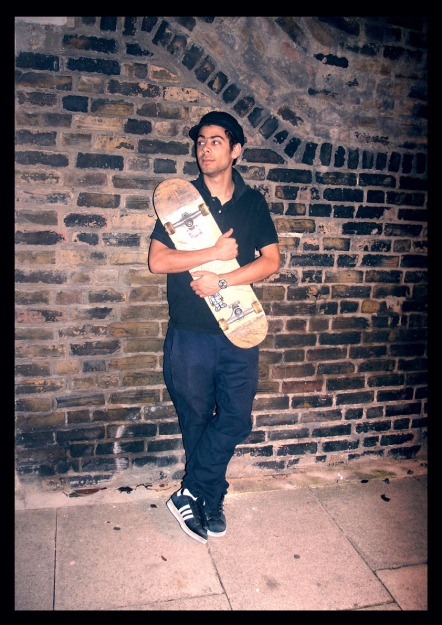Title: …
Artist: Elizabeth Aspden
Type: Inkjet photographic print
Date: 2007
Description: …, London. Completed May 2007. Made in response to Anita Corbin’s photographic series ‘Visible Girls’, Girls Subcultures box held at the London South Bank University, London. A series of … images.
Subject: …, subcultures
Measurements: …x…
Location: London South Bank University Digital Photography Dept
ID Number: PI-RGSB-EA0001-EA00…
Licensing: Creative Commons Attribution-Noncommercial 2.0 UK: England & Wales, Elizabeth Aspdenc/o London South Bank University, Digital Photography Course, UK
Subcultures and Contemporary Youth Cultures in 2007
This assignment was undoubtedly one of the most challenging I have faced so far. The reason I found it so challenging was because I could not define exactly how subcultures was relevant to Anita Corbin’s Visible Girls photographs. When I looked at her work, all I saw was the fashions of young girls at that time. I was aware that the girls dressed in many different styles and they all liked different music etc. As far as I saw it, they were simply young girls expressing themselves. Girls in the 1980’s were using fashion to stand out and be individual. Maybe they were all part of different subcultures, or, maybe they were just being fashionable.
Within our group we have discussed what we think subcultures are. Many of us see how subcultures are constantly seeping over to the mainstream. Take punks for example. To be a punk was to go against the beliefs and styles of the masses. Marketing executives saw that it was cool to be punk and realised they could sell it. Punk became commercial. So now so called “punks” can buy their alternative clothing on the High Street. I like to call the new generation of punks “perfumed punks”. This has created an oxymoron – mainstream/alternative. It seems now that everything that was alternative, has become mainstream. Making mainstream the new alternative. I became very confused. To make it easier for myself to understand I replaced the word subculture for youth culture. For me Anita Corbin represented youth-culture more than subculture.
Our assignment was to interpret Anita Corbin’s Visible Girls collection. Firstly I wanted to take photographs of my co-workers. We are an all girl landscaping team. I thought this would be interesting because all the girls I work with are so different from each other. There all have sideline jobs, for example a massage therapist, a band manager, a carpenter one of the girls is even a model. This was a nice example of diversity within girl culture. However there was a big problem with my idea. I felt they were too old. Their age range was between twenty-two and thirty-five. This was not exactly youth culture.
I had to re-assess what was at the core of Anita’s work. And for me she was showing the styles of young people at the time. I decided to change my Idea, I thought to keep it simple and show the styles of young people now. I wanted to do this because Anita’s photographs interested me in the way you got to look at how people used to dress. I decided to do a set of portraits to document how young people dress now.
I am going to be quite honest, I have never really cared too much about the way people dress. I often wonder why people bother to dress “alternatively”. I think it looks more silly than cool. It is no longer cool to be different. It is no longer different to be “different”. I will explain what I mean. If I look at the people I am friends with, we do not all dress the same. In one room there could be a hippy, a goth, and indie kid, all getting along, all enjoying the same music. Within our group we can all be different together. Circles of friends seem to have become more relaxed. There is no need to belong to a specific set of people, as it has become easier to be accepted amongst a wider group. People are free to be whom they want in this day and age.
With my photos I am trying to show how our culture allows people to be comfortable with whom they are. They are free to express themselves through their dress styles. This expression is generally shown through clothing styles. The people in my pictures consist of a musician, a homosexual and a bar person. But who is who? It is not so easy to understand people by the way they dress. I hope to have captured their real personalities despite of this.





This project really drew me in to the subject matter after reading the explanation of the concept. Aside from the aesthetic quality of the photographs I think the ideas behind the pictures were easily recognisable and very original.
I feel that although you say you replaced the word subculture with ‘youth culture’, I think that these pictures still have a strong element of subcultures deeper than just fashion and would question whether the clothing styles and hobbies are synonymous with youth culture as an umbrella term, anyway, i digress.
I admire your stance on mainstream and alternative fashion, and think perhaps the revolving door of fashion has a way of moulding the two together which is a bit confusing, for example, the Mod attire that some of the ‘invisible girls’ wore was seen to be rebellious at the time but now it’s commonplace to see people dressed like this now as a part of mainsream fashion with certain high street retailers (urban outfitters, topman) promoting this style.
I think this is an inventive piece of work which can be read into at different levels. Awesomeeee!!
Dominic Dawkins